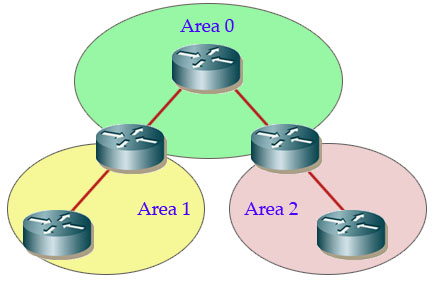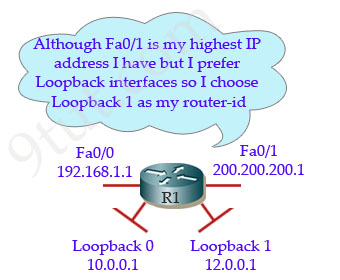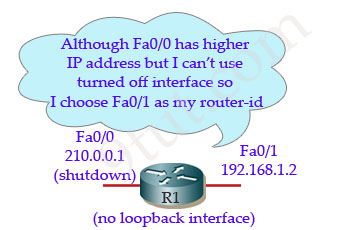OSPF Tutorial
In this article we will learn about the OSPF Routing Protocol
Open-Shortest-Path-First (OSPF) is the most widely used interior gateway protocol routing protocol on the world because it is a public (non-proprietary) routing protocol while its biggest rival, EIGRP, is a Cisco proprietary protocol so other vendors can’t use it (edit: EIGRP has become a public routing protocol since 2013). OSPF is a complex link-state routing protocol. Link-state routing protocols generate routing updates only when a change occurs in the network topology. When a link changes state, the device that detected the change creates a link-state advertisement (LSA) concerning that link and sends to all neighboring devices using a special multicast address. Each routing device takes a copy of the LSA, updates its link-state database (LSDB), and forwards the LSA to all neighboring devices.
Note:
+ OSPF routers use LSA (Link State Advertisement)to describe its link state. LSDB stores all LSAs.
+ A router uses Router LSA to describe its interface IP addresses.
+ After OSPF is started on a router, it creates LSDB that contains one entry: this router’s Router LSA.
There are five types of OSPF Link-State Packets (LSPs).

+ Hello: are used to establish and maintain adjacency with other OSPF routers. They are also used to elect the Designated Router (DR) and Backup Designated Router (BDR) on multiaccess networks (like Ethernet or Frame Relay).
+ Database Description (DBD or DD): contains an abbreviated list of the sending router’s link-state database and is used by receiving routers to check against the local link-state database
+ Link-State Request (LSR): used by receiving routers to request more information about any entry in the DBD
+ Link-State Update (LSU): used to reply to LSRs as well as to announce new information. LSUs contain seven different types of Link-State Advertisements (LSAs)
+ Link-State Acknowledgement (LSAck): sent to confirm receipt of an LSU message
|
Key points + Is a public (non-proprietary) routing protocol. + Is the only link-state routing protocol you learn in CCNA + This works by using the Dijkstra algorithm + Information about its neighbors (local connectivity) is sent to the entire network using multicasting + Routing information is shared through Link-state updates (LSAs) + HELLO messages are used to maintain adjacent neighbors. By default, OSPF routers send Hello packets every 10 seconds on multiaccess and point-to-point segments and every 30 seconds on non-broadcast multiaccess (NBMA) segments (like Frame Relay, X.25, ATM). + Is a classless routing protocol because it does not assume the default subnet masks are used. It sends the subnet mask in the routing update. + Supports VLSM and route summarization + Uses COST as a metric which CISCO defines as the inverse of the bandwidth + Uses AREAs to subdivide large networks, providing a hierarchical structure and limit the multicast LSAs within routers of the same area — Area 0 is called backbone area and all other areas connect directly to it. All OSPF networks must have a backbone area + Only support IP but it’s not bad as we are all using IP, right? :) |
Area Border Routers (ABR) are any routers that have one interface in one area and another interface in another area
Let’s see an example of OSPF
Suppose OSPF has just been enabled on R1 & R2. Both R1 and R2 are very eager to discover if they have any neighbors nearby but before sending Hello messages they must first choose an OSPF router identifier (router-id) to tell their neighbors who they are. The Router ID (RID) is an IP address used to identify the router and is chosen using the following sequence:
+ The highest IP address assigned to a loopback (logical) interface.
+ If a loopback interface is not defined, the highest IP address of all active router’s physical interfaces will be chosen.
+ The router ID can be manually assigned
In this example, suppose R1 has 2 loopback interfaces & 2 physical interfaces:
+ Loopback 0: 10.0.0.1
+ Loopback 1: 12.0.0.1
+ Fa0/0: 192.168.1.1
+ Fa0/1: 200.200.200.1
As said above, the loopback interfaces are preferred to physical interfaces (because they are never down) so the highest IP address of the loopback interfaces is chosen as the router-id -> Loopback 1 IP address is chosen as the router-id.

Suppose R1 doesn’t have any loopback interfaces but it has 2 physical interfaces:
+ Fa0/0: 210.0.0.1 but it is shut down
+ Fa0/1: 192.168.1.2 (is active)
Although Fa0/0 has higher IP address but it is shutdown so R1 will choose Fa0/1 as its router-id.

Now both the routers have the router-id so they will send Hello packets on all OSPF-enabled interfaces to determine if there are any neighbors on those links. The information in the OSPF Hello includes the OSPF Router ID of the router sending the Hello packet.



Hey Dex,
Did you take your ICND1 exam on November 16, 2019 ? If yes, how was it ?
Can anyone send me the latest CCNA dump for me at calvinangla(at)hotmail(dot)com
Can someone please send me latest ICND2 dumps in my email najimaji15(at)yahoo(dot)com
Thanks guys! Just passed my ccna with 910 score, this is the second time I’m using 9tut for CCNA test, will always recommend and use!! Thanks again!!
People please, pay for the premium, you will be happy you did. Don’t ask for dumps randomly, 9tut guys really do their homework to help us out and it works! supported them!
Nice Explanation, but I think you forgot to add OSPF configuration commands in this tutorial, it is only theoretical without commands.
Thanks
“Is the only link-state routing protocol you learn in CCNA” why there are EIGRP questions on the exam? You really should put configuration chapter in here
@Stef “Is the only link-state routing protocol you learn in CCNA” why there are EIGRP questions on the exam? – EIGRP is not a link state protocol
Can someone pls send me ICND1&2 dumps for me {email not allowed}